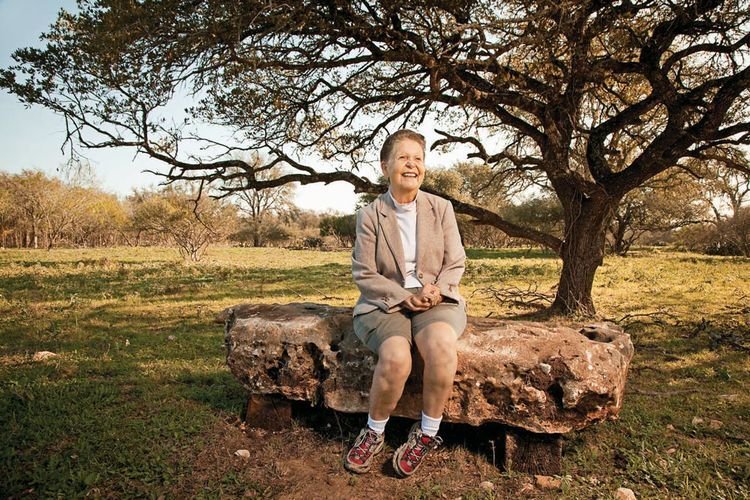Gay Ruby Dahlstrom Nature Preserve
Ranch owner Gay Ruby Dahlstrom Photo: Buda Mill & Grain Co.
“If you want a good sermon, walk out into this country; that is where things come together.” —Gay Dahlstrom
Tom Jones
Undeveloped land in the Hill Country is vital for the protection of wildlife habitat, outdoor recreation, and spiritual renewal, but also critical to sustainable supplies of water. The abundance of karst terrain creates vast areas of porous limestone, which is the origin of the huge Edwards and Trinity (Cow Creek) aquifers. These two aquifers are a primary source of water for millions of people. These same remarkable resources are also responsible for hundreds of iconic Hill Country springs and rivers, including the Blanco River, the Guadalupe River, the San Marcos River, the Comal River, and many others. They would not exist without the continued recharge of rainfall flowing into the aquifers from open lands within the Hill Country.
“The Dahlstrom Ranch is such a place. Scattered across its rolling hills and swales are sinkholes that allow rainwater to flow directly into the aquifer. On the Dahlstrom, rainfall pours into numerous openings in the limestone, with names like Hobbit Hole and Possumhaw Sink, and disappears so rapidly that it is reminiscent of water flowing out of a bathtub. These natural drains are uninterrupted conduits to the groundwater resources below and account for 8 million cubic feet of replenishment to the aquifer out of an astonishing total of 72 million cubic feet of water recharged from the Dahlstrom Ranch alone each year.” (Texas Parks & Wildlife Magazine, July 10, 2010)
A significant recharge feature is Cripple Crawfish Cave near the Dahlstrom Ranch. Onion Creek flows directly into the cave and the Edwards Aquifer. Water rushing into the cave creates a whirlpool in the Creek during high flow conditions. (Austin Geological Society)
Possumhaw Sink is a unique karst feature—a cave in the limestone that allows water to flow down to the Edwards aquifer below. Photo: Bohemian Adventures Newsletter, February, 2017.
In 2001 ranch owner Gay Dahlstrom had a vision of the future for her family’s land. She wanted to prevent the land from ever being divided or developed. She began to create a plan to preserve the ranch while allowing her family to continue to own and manage the land. In 2007 talks began to negotiate a conservation easement / preservation agreement. In 2008, a conservation easement for the 2,254-acre Dahlstrom Ranch was executed between the Dahlstrom Family, Hays County, the City of Austin, and the Hill Country Conservancy.
As part of this agreement, a unique decision was made to create a nature preserve on a portion of the easement that allowed for public access on private land. This 384-acre portion was once called the John Howe tract or Howe Pasture; it had been the last piece of land Cecil Ruby added to his ranch and is slightly larger than Zilker Park (350-acre). This land is only a sub-section of the privately owned 2,254-acre Dahlstrom Ranch on Onion Creek. The Preserve is set up as a limited lease between Hays County and the Dahlstrom Family, which allows public access for up to 20 years. This unique public access agreement is all thanks to Gay Ruby Dahlstrom.
Large sinkhole with protective wire net to prevent cattle and people from falling in.
Rainfall easily enters the Edwards Aquifer though large sinkholes like this. Note the protective steel cover to protect visitors from injury.
With a family history dating back five generations, the Dahlstrom Ranch is a central part of our region’s rich heritage. The Dahlstroms were concerned about whether they would have to sell some or all of their land in order to pay impending estate taxes. Gay Ruby Dahlstrom instead chose to preserve her family’s heritage and legacy by obtaining a conservation easement, which allowed her family to keep the natural character of the ranch intact.
“At the end of the day, my mother did this because she loves this land and appreciates all that it has given us,” Jack Dahlstrom, Jr., Gay’s son, said. “Now it’s our family’s turn to give back to the land, and we appreciate the efforts of everyone who worked so hard to help us make that happen.”
Dye tracing studies confirmed that rainfall collected in this recharge area contribute to Barton Springs.
Preservation efforts on the Dahlstrom Ranch enhance healthy recharge of underlying aquifers and affect the quality of a broad swathe of Central Texas. Dye tracing studies confirmed that rainfall collected on the Dahlstrom Ranch’s recharge area contributes to Barton Springs. Non-toxic organic dyes were injected into two caves located within Onion Creek at the GRD Preserve. The goal was to trace groundwater flow paths and determine groundwater flow velocities. Antioch and Cripple Crawfish Caves are located about 14.0 and 17.5 miles south, respectively, of Barton Springs, the primary discharge point from the Edwards aquifer. Twenty-five pounds of sodium fluorescein were injected into Antioch Cave on August 2, 2002 and arrived at Barton Springs between 7 to 8 days after the injection.
Thirty-five pounds of eosine were injected into Cripple Crawfish Cave on August 6, 2002 and arrived at Barton Springs in less than 3.5 days after the injection. Under high spring flow conditions, groundwater flow velocities from Antioch Cave and Cripple Crawfish Cave to Barton Springs are estimated to be 2.0 and 5.0 miles per day respectively. (Austin Geological Society Bulletin, 2005)
This article was initially published in the July 2019 Hays Humm and it has been edited and updated for the December 2022 edition.
See the well camouflaged rattlesnake in the center of the photo? While hiking the Cicada Trail on Dahlstrom Ranch Preserve, I was lucky to see it and avoid stepping on it! A nature preserve is, after all, a wild place and should be respected.

